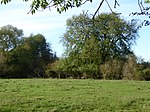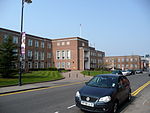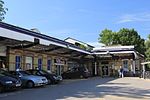Maidenhead Railway Bridge, also known as Maidenhead Viaduct and The Sounding Arch, carries the Great Western Main Line (GWML) over the River Thames between Maidenhead, Berkshire and Taplow, Buckinghamshire, England. It is a single structure of two tall wide red brick arches buttressed by two over-land smaller arches. It crosses the river on the Maidenhead-Bray Reach which is between Boulter's Lock and Bray Lock and is near-centrally rooted in the downstream end of a very small island.
The Maidenhead Bridge was designed by the Great Western Railway Company's engineer, the noted mechanical and civil engineer Isambard Kingdom Brunel, and it was completed in 1838, but not brought into use until 1 July 1839. While it was being constructed, the innovative low-rise arches of the structure attracted considerable criticism and controversy surrounding their alleged lack of stability; as a result, the centring for the arches was left in place until its destruction during a heavy storm in late 1839, yet the arches stayed up, effectively vindicating Brunel's design. During 1861, dual-gauge track was installed across the structure, allowing both broad gauge and standard gauge services to cross it. During the late 1890s, the bridge was widened on either side to allow the structure to carry an arrangement of four standard gauge tracks, a task which was supervised by the civil engineer Sir John Fowler, who placed a high level of importance upon preserving the bridge's original design and appearance.
Today, the Maidenhead Bridge forms a key crossing along the eastern section of the Great Western Main Line, allowing trains to proceed to and from the line's terminus in the capital, London Paddington station. During the 2010s, the tracks across the structure were provisioned with overhead line equipment and associated infrastructure as to allow electric traction to use the route. The Maidenhead Bridge features in Rain, Steam and Speed – The Great Western Railway, painted by J. M. W. Turner during 1844 and now in the National Gallery, London. It is approximate to the finish line of an annual day of rowing races, known as the Maidenhead Regatta. The Thames towpath passes directly under the right-hand arch (facing upstream), which is also known as the Sounding Arch as a result of its spectacular echo. During July 2012, the Maidenhead Railway Bridge was upgraded to a Grade I listed structure in light of its historical importance; to this day, the arches of the structure remain the flattest to have ever been constructed.











